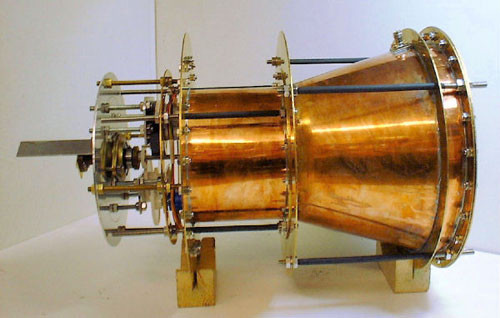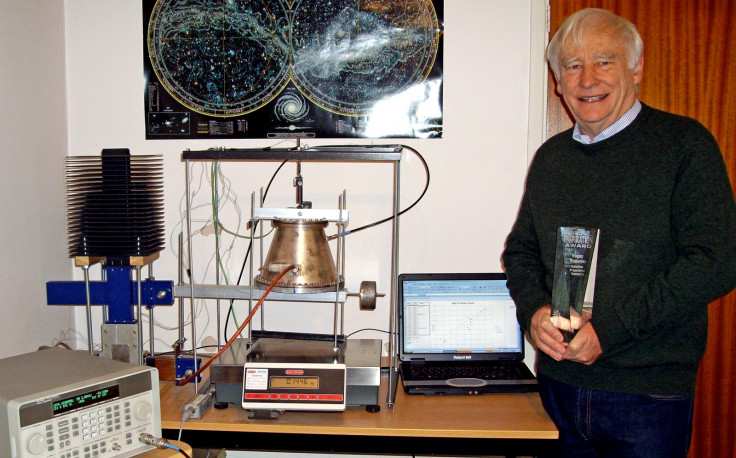What is the EmDrive and why should I care?
IBTimes UK explains the controversial space propulsion invention setting the global scientific community alight.
If you have a casual interest in space science and technology, you might have heard the phrase "EmDrive" being bounced around in the media, on online forums and on social bookmarking sites like Reddit.
- [UPDATE - 19:01 BST, 2 August 2016] EmDrive: AIAA confirms release date of controversial Nasa Eagleworks space propulsion paper
But it's all very complicated and there are a lot of differing opinions, plus some media publications keep talking about Star Trek-like "warp drives" and impossibly fast space travel, so it's easy to see why you could get confused.
IBTimes UK has been covering the EmDrive story since 2014 and a lot has happened since then, so here's a breakdown of the most important facts you need to know about this controversial space propulsion technology – which may or may not actually work.
What is the EmDrive?

The EmDrive is a new type of rocket engine first proposed by British scientist/electrical engineer Roger Shawyer in 1999. Unlike conventional space rocket engines, the EmDrive doesn't require any kind of propellant (also known as a reaction mass) to make propulsion possible.
The idea is that electricity is converted into microwaves, and the microwave photons are fired into a truncated cone-shaped closed metal cavity. When fired into the cavity, the microwave photons push against the large end of the cone, causing the small end to accelerate in the opposite direction.
If its potential could be realised, Shawyer believes EmDrive could transform the aerospace industry and potentially solve both the energy crisis and climate change by making it much cheaper to launch satellites and spacecraft into orbit, as well as helping to extend the operational lifetime of satellites.
If you could get more satellites into space, some of them could be used to harness solar energy or to act as a shield against global warming. The technology would also make space travel much faster (but not warp speed fast) and make flying cars feasible.
For greater detail, watch the video presentation featuring narration by Shawyer on the basic science behind the EmDrive:
So what's all the controversy about?
Many academics in the international scientific community don't believe it is remotely possible for the EmDrive to work. They say that according to the law of conservation of momentum, in order for a thruster to gain momentum in one direction, a propellant must be expelled in the opposite one, and since the EmDrive is a closed system with no propellant, it violates our understanding of physics.
But this is a debate with a lot of history. In 2006, EmDrive was first highlighted when the New Scientist decided to write about it. At the time, Shawyer was being funded by the UK government to develop the EmDrive.
The New Scientist article led to a massive backlash from readers, academics and armchair scientists, and Shawyer was ridiculed and even accused of fraud. Despite this, the UK government was satisfied that Shawyer's results were legitimate and continued to fund his work until the research project was completed in 2007. In 2009, Boeing paid the UK government to licence the technology so that they could develop it for the US military, but their progress is still being kept under wraps.
Who is Roger Shawyer?

Roger Shawyer, 69, is a certified chartered electrical engineer who spent 40 years working in the space and defence industry on UK government defence contracts, primarily for BAE Systems and Matra Marconi Space (now Airbus).
During his career, he was a senior engineer who was project manager for multiple satellite contracts including the Skynet 4 military satellite, the NATO-4 satellite serving Nato and the British Ministry of Defence, and the French Euteselat Hot Bird TV broadcast satellite.
Over the last 15 years, Shawyer's work in developing the EmDrive with his own company Satellite Propulsion Research Ltd has seen him take on the additional mantle of scientist, even though his experiments and explanations of the results continue to be hotly contested by many in the science community.
So does this thing actually work then?

We're currently at the point where multiple groups of scientists have attempted to build their own versions of the EmDrive to see what happens. Even though it shouldn't be possible, they have all recorded very small levels of thrust being produced, which would seem to indicate that it works. But the issue is that no one really knows how.
Shawyer claims that following fundamental physics involving the theory of special relativity, the EmDrive does in fact preserve the law of conservation of momentum and energy. However, even the scientists who do believe the EmDrive works don't believe that it works for the reason Shawyer says.
Some scientists, for example Dr Mike McCulloch of Plymouth University and Dr Arto Annila from the University of Helsinki, have attempted to use an area of research known as "new physics" to try to explain why the EmDrive works, and they have seen that the thrust detected in experiments by Shawyer and other scientists matches their theoretical calculations.
What will happen next?

An experimental lab in Nasa, known as Nasa Eagleworks, has conducted experiments on the EmDrive and has repeatedly posted updates on the Nasa Spaceflight enthusiasts forum indicating that their device has produced thrust.
In March, Eagleworks engineer Paul March announced that his team had a paper currently going through the peer review process. On 2 September, the American Institute of Aeronautics and Astronautics (AIAA) Journal of Propulsion and Power confirmed that it would indeed be publishing a paper on the EmDrive in December 2016.
The open access paper, entitled "Measurement of Impulsive Thrust from a Closed Radio-Frequency Cavity in Vacuum" was published online on Thursday 17 November.
This followed the news on 29 August, posted by independent scientist and EmDrive sceptic Dr José Rodal on the Spaceflight forum, that the Nasa Eagleworks paper had indeed passed peer review.
As Nasa considers Eagleworks to be a sort of "moonshot" experimental laboratory for investigating fringe theories in advanced propulsion physics, everyone is waiting to see whether the US space agency will ever officially acknowledge and endorse the technology — so far, it has not, despite the publication of the AIAA paper.
Shawyer doesn't care either way, though. He is now working with an unnamed UK aerospace company on developing the second generation of EmDrive (let's call it EmDrive 2.0), which will produce many orders of magnitude more thrust.
To him, the EmDrive will likely be commercialised by the private space industry, no matter what the naysayers think. Even if Nasa and other scientists validate his invention, their test results would still be about a decade behind his research, although he does appreciate the renewed interest in his work.
Why do you guys keep reporting about this when it might not work?
Because no one knows for sure yet. There is a great deal of interest on both sides, and no one is able to explain why multiple different groups of scientists continue to report levels of thrust, including renowned space scientists known for debunking space technologies.
Whatever happens, we'll be there. And if anyone can equivocally prove that the EmDrive definitely doesn't work through experiments and peer reviewed papers, we will report that too.
© Copyright IBTimes 2025. All rights reserved.






















